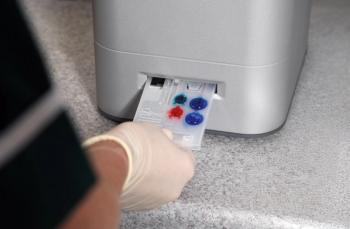
Get wired up
Plug yourself and your team into the latest technology to improve communication-and your bottom line.
Two tin cans and several yards of string worked fine when you were 8 years old, but now you need some serious communication tools in your practice—tools that will help you coordinate appointments and emergencies, and communicate changing client information with your staff. Easier said than done? Taking the next step may be easier than you think. And the latest communication tools can do a lot to ward off crises and improve efficiency.
Susan Miller, co-founder of Christopher B. Miller, DVM, PC, a 100 percent ambulatory practice based in North Salem, N.Y., and her team take the cake for dealing with what some might view as a potential communication nightmare waiting to happen. Half of the team moves to Florida to work at horse shows in the winter. Yes, that's right. Half of their four doctors, four office staff members, two full-time technicians, and several part-timers hit the road.
"I can't imagine operating without technological tools like cell phones and pagers," says Miller. "We've always been ahead of the game with technology and when we opened the practice in 1997 we knew that to be successful, we'd need to tap technology right away."
Tools you can use
Everything's wireless these days so you're no longer tied to your office thanks to the latest technology in cell phones, laptops, and PDAs. "I heard a quote once that said good technology makes your desk irrelevant," says Dr. Andy Clark, CEO of the Hagyard Equine Medical Institute in Lexington, Ky. "It's true. These systems let you be where you're productive, yet you're in touch with your team."
Beyond basic text messaging and voicemail, some phones come with all kinds of bells and whistles from high-speed, built-in Web browsers to e-mail access. And a laptop you carry with you in your truck could provide even more communication options.
Each doctor at Miller's practice is equipped with a cell phone, BlackBerry, pager, and laptop. And every day her staff uses e-mail and text messaging to reach doctors in the field. The method the team uses to communicate with the doctors depends on the priority of the message.
"If something's really urgent, we'll page the doctor," says Miller. "And if we need to make a quick change in the schedule, like we need the doctor to make a stop down the road to see a patient or answer a question, we'll send a text message. For just about everything else, we'll send an e-mail."
On the doctors' end, they enter the day's records into the laptop and then network to the server. This approach keeps everyone—everywhere—up to date. "When the doctors are in Florida," says Miller, "they can work remotely so that the staff members that stay behind are up to date." Yes, you too could communicate with such ease.
Dr. Keith Wagner, owner of Equine Health Solutions in Raymore, Mo., equipped his truck with a laptop that's updated daily with the practice's appointment book. If any changes occur in the schedule, the receptionist notifies Dr. Wagner via cell phone. The computer also gives Dr. Wagner easy access to patient's medical records. "We transfer information into the laptop every day," he says. "Having it in the truck has been indispensable." And the set up lets Dr. Wagner bill and collect at the time of service. "Without a computer, I just couldn't do that," he says.
The learning curve
Learning to use new technology takes time, but that's not an excuse not to use it. "People feel intimidated when they're faced with something new," says Dr. Clark. "It isn't that people don't want to learn, but they're comfortable where they are. Some people stopped expanding their comfort zone at the fax machine, so you have to communicate with them by fax."
To help her team members overcome common technological problems, Miller gives them typed, step-by-step instructions. This quick guide gives them a resource to turn to if they get stuck.
In addition to learning how to use the technology and feeling comfortable with it, everyone on your team will need to learn each other's communication preferences. Some people prefer to use e-mail almost exclusively. Others might not want to use it—ever. "You have to learn what your team wants because the only way to communicate effectively is to do so in a way that's meaningful to them," Dr. Clark says.
Miller says she's seen examples of this at her practice. "Some of the doctors embraced the technology right away," she says. "They keep their laptop with them at all times, and enter information directly into the system. But one still writes everything out by hand, then enters it into the computer."
Back to basics
Now that you're on your way to mastering technology, consider putting your communication plan into overdrive with a few simple strategies. Dr. Wagner checks the log his receptionist keeps of every phone call that comes into the practice. "I glance through it on a regular basis; it allows me to stay up to speed on what's going on in the practice," he says. "We also use it to see how many calls we get in a week, how many of those calls turn into appointments, how many are just questions, or new clients. That log helps us manage our practice."
And in a world where technology is evolving at a rapid pace, you literally could go days without actually talking to someone. So a little face-to-face time is good. Miller's team holds regular bi-weekly staff meetings, and the doctors meet every week to catch up on cases. "We use the staff meetings as a time to tweak our approach with the technology and discuss any issues face-to-face," she says. "Maybe a doctor isn't responding to e-mail within a time frame that's efficient for the team. We'll talk about it and see how we can communicate even better."
Bet your bottom dollar
There are probably some of you reading this who remember a time when you practiced medicine without pagers, cell phones, and laptops—and clients were just fine with your service. But times have changed. "Customers of every business expect immediate service," says Dr. Clark. "And without technology we'd suffer. Productivity as we know it would suffer, but customer service would suffer the most."
Miller agrees. "We're effectively able to see more clients because we're efficient, accurate, and able to provide great service. This translates directly to the bottom line." And you can enjoy the benefits of improved efficiency, too.
Newsletter
From exam room tips to practice management insights, get trusted veterinary news delivered straight to your inbox—subscribe to dvm360.




